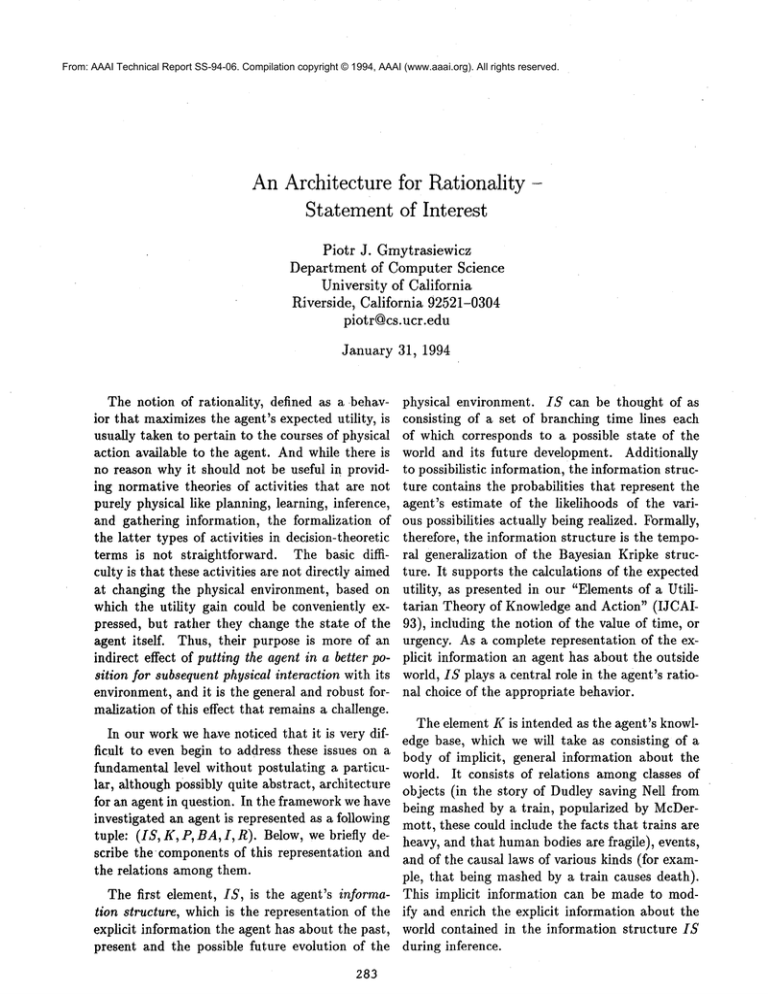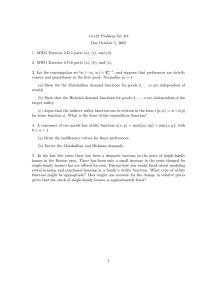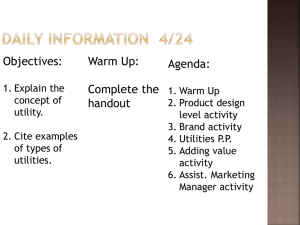
From: AAAI Technical Report SS-94-06. Compilation copyright © 1994, AAAI (www.aaai.org). All rights reserved.
An Architecture for RationalityStatementof Interest
Piotr J. Gmytrasiewicz
Department of Computer Science
University of California
Riverside, California 92521-0304
piotr@cs.ucr.edu
January 31, 1994
The notion of rationality, defined as a behavior that maximizesthe agent’s expected utility, is
usually taken to pertain to the courses of physical
action available to the agent. Andwhile there is
no reason why it should not be useful in providing normative theories of activities that are not
purely physical like planning, learning, inference,
and gathering information, the formalization of
the latter types of activities in decision-theoretic
terms is not straightforward. The basic difficulty is that these activities are not directly aimed
at changing the physical environment, based on
which the utility gain could be conveniently expressed, but rather they change the state of the
agent itself. Thus, their purpose is more of an
indirect effect of putting the agent in a better position for subsequent physical interaction with its
environment, and it is the general and robust formalization of this effect that remains a challenge.
In our work we have noticed that it is very difficult to even begin to address these issues on a
fundamental level without postulating a particular, although possibly quite abstract, architecture
for an agent in question. In the frameworkwe have
investigated an agent is represented as a following
tuple: (IS, K, P, BA, I, R). Below, we briefly describe the components of this representation and
the relations amongthem.
The first element, IS, is the agent’s information structure, which is the representation of the
explicit information the agent has about the past,
present and the possible future evolution of the
283
physical environment. IS can be thought of as
consisting of a set of branching time lines each
of which corresponds to a possible state of the
world and its future development. Additionally
to possibilistic information, the information structure contains the probabilities that represent the
agent’s estimate of the likelihoods of the various possibilities actually being realized. Formally,
therefore, the information structure is the temporal generalization of the Bayesian Kripke structure. It supports the calculations of the expected
utility, as presented in our "Elements of a Utilitarian Theory of Knowledge and Action" (IJCAL
93), including the notion of the value of time, or
urgency. As a complete representation of the explicit information an agent has about the outside
world, IS plays a central role in the agent’s rational choice of the appropriate behavior.
The element K is intended as the agent’s knowledge base, which we will take as consisting of a
body of implicit, general information about the
world. It consists of relations amongclasses of
objects (in the story of Dudley saving Nell from
being mashed by a train, popularized by McDermott, these could include the facts that trains are
heavy, and that humanbodies are fragile), events,
and of the causal laws of various kinds (for example, that being mashed by a train causes death).
This implicit information can be made to modify and enrich the explicit information about the
world contained in the information structure IS
during inference.
The preferences, P, represent the assignment of
utility to the states of the world. For Dudley, for
example, the states of the world in which Nell is
dead are not desirable, and less preferable to the
states in which Nell is only scared, which are in
turn less preferable to her not being negatively affected at all. It is frequently convenient to represent preferences as a hierarchical structure depicting the more general preferences being composed
of the more specific ones. For example, Dudley’s
Concern for Nell’s well-being could be composedof
physical and mental factors, while his preference
not associated with Nell mayinclude material factor measured in USdollars. As we mentioned, the
preference hierarchy is used to assign desirability
to states of the world, and further, to time lines,
whole information structures and finally, actions.
Theexplicit inclusion of the preferences in the formal make-up of the agent gives us the ability to
talk of the purposeful nature of an agent. The
agent’s purpose and the driving factor behind all
of its undertakings is the maximization of the expected utility specified by the attributes contained
in the preference hierarchy.
BA is the set of basic actions that the agent
is capable of performing, that is the actions for
which no additional planning is required to make
them executable. It seems desirable to postulate
that all of the computational, sensory, as well as
physical actions belong to this set and be treated
on an equal footing, although their character and
effects differ substantially. Physical actions influence the agent’s physical environment, and sensing actions change the agent’s knowledge of the
physical environment, as represented by the information structure IS. The computational actions
are themselves diverse and influence different elements of the agent’s state. For example, planning actions maintain and elaborate the agent’s
intentions I. Inference actions can be roughly described as aimed at transforming the general implicit knowledge contained in the knowledge base
K into the explicit representation of the environment in the information structure.
I is the agent’s current intention structure,
which consists of a planning hierarchy supplemented with the expected utility assignments to
plans at the leaves of the hierarchy. The leaf that
284
has the highest expected utility is defined to be
the agent’s current intention. The agent’s intention is, therefore, closely related to the process of
planning, to its beliefs about the environment residing in the information structure IS, and to its
preferences. In other words, we are postulating
that the agent’s intentions are to be viewed as rational consequences of the agent’s explicit beliefs
about the world, contained in IS, and its preferences P. Each of the plans in the intention structure is formed as a sequence of one or more actions, which are behavioral specifications on any
level of abstraction, lowest of which are the basic
actions of the agent. The plans grow progressively
more detailed as they become elaborated during
the planning process.
R is the set of reactive rules, application of
which relieves the agent from rational deliberation. Wetake reactions to be compilations of, or
short-cuts through, the general but tedious rational decisionmaking processes. The construction
and usage of such compilations was investigated
before by Heckermanand by Russell, and we will
build on this work to integrate reactive behaviors
into our framework.
Our basic approach to assessing the utilities of
actions and plans can be found in our "Elements
of a Utilitarian
Theory of Knowledge and Action" (IJCAI-93). In this approach actions are
treated as transformations of the agent’s information structure IS, and the expected utilities
of physical and sensing actions can be computed
as a difference between the utilities of IS’s after
and before a given action. Since inference can be
thought of as enriching the explicit information in
the information structure using the explicit knowledge in K, we expect that a similar approach can
be used to computethe expected utilities of inferencing actions. A remaining challenge is to formalize the utility of the planning actions themselves,
which is the focus of our present research.







